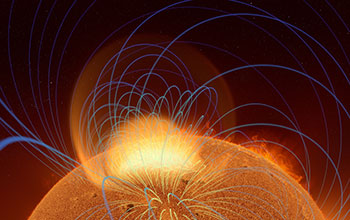Multimedia Gallery
Tangle of magnetic fields rising from a sunspot region
A tangle of magnetic fields rising from a sunspot region. This simulation of the coronal mass ejection was conducted by Yuhong Fan and the solar surface simulation was done by Matthias Rempel, both from the National Center for Atmospheric Research. Their data was visualized by the Advanced Visualization Laboratory team at the National Center for Supercomputing Applications.
More about this image
The Advanced Visualization Laboratory at the National Center for Supercomputing Applications (NCSA) worked with astrophysics data scientists to create a narrative journey through the dynamic processes of the sun in a digital, fulldome production titled "Solar Superstorms," narrated by Benedict Cumberbatch, as part of a National Science Foundation-supported grant (ACI 14-45176). This visualization represents part of the story of the dynamic processes of the sun, and how they affect life on Earth.
Yuhong Fan’s magnetohydrodynamic simulation of the development of a homologous sequence of two coronal mass ejections (CMEs) demonstrates their so-called cannibalistic behavior. These CMEs originate from the repeated formations and partial eruptions of kink unstable flux ropes as a result of continued emergence of a twisted flux rope across the lower boundary into a preexisting coronal potential arcade field. The simulation shows that a CME erupting into the open magnetic field created by a preceding CME has a higher speed. The second CME is cannibalistic, catching up and merging with the first into a single, fast CME before exiting the domain.
Fan simulated her non-uniform spherical grid data on the Yellowstone supercomputer at the National Center for Atmospheric Research (NCAR). The simulation shows the explosive power of ionized plasma that can be projected from the sun toward Earth. AVL shows Fan’s magnetic field lines in blue/cyan, traced between points on the sun’s surface, and a current field (|curl B|), computed from the simulation’s magnetic field in yellow/orange. As the CMEs expand, note that the current is concentrated into a thin, rippling sheet, reminiscent of auroras on Earth, where current sheets are also involved. The solar surface simulation was done by Matthias Rempel of NCAR.
You can learn more about the movie "Solar Superstorms" on the movie's website. (Date image taken: 2015; date originally posted to NSF Multimedia Gallery: May 3, 2017)
Credit: Solar Superstorms Production Group Inc.
See other images like this on your iPhone or iPad download NSF Science Zone on the Apple App Store.
Images and other media in the National Science Foundation Multimedia Gallery are available for use in print and electronic material by NSF employees, members of the media, university staff, teachers and the general public. All media in the gallery are intended for personal, educational and nonprofit/non-commercial use only.
Images credited to the National Science Foundation, a federal agency, are in the public domain. The images were created by employees of the United States Government as part of their official duties or prepared by contractors as "works for hire" for NSF. You may freely use NSF-credited images and, at your discretion, credit NSF with a "Courtesy: National Science Foundation" notation.
Additional information about general usage can be found in Conditions.
Also Available:
Download the high-resolution JPG version of the image. (6.2 MB)
Use your mouse to right-click (Mac users may need to Ctrl-click) the link above and choose the option that will save the file or target to your computer.



